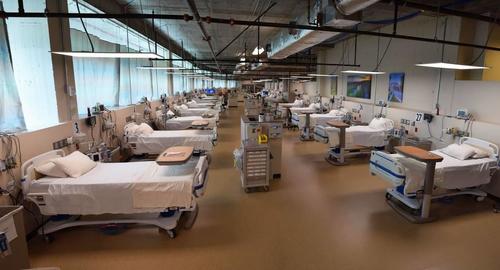Data Shows Fears Of Overwhelmed Medical System Overblown, Ample Hospital Capacity Nationwide Tyler Durden Mon, 12/14/2020 - 18:00
According to federal government data reported by Just The News, hospitals nationwide have 'considerable space left to deal with both routine medical issues and COVID-19 patients," dispelling fears of overwhelmed medical systems and at-capacity hospitals which have been promoted by the usual media suspects.

For most of 2020, rising positive test results of COVID-19 have brought with them fears of swamped hospitals, overwhelmed medical systems, emergency patients being turned away, and COVID-19 patients being triaged, suffering and dying in hallways and vestibules.
Much of that fear crystallized in the early stages of the pandemic, when parts of the northern Italian medical system were put under significant strain due to a crush of COVID-19 patients. In response, leaders and medical officials around the world suspended elective surgeries and constructed emergency medical facilities to cope with anticipated waves of COVID-19 patients. -Just The News
Yet, many care facilities which beefed up resources for a flood of COVID-19 patients have been virtual ghost towns - with some being shuttered for a lack of patients despite millions of dollars devoted to their construction. In Chicago, the city spent $120 million on four facilities which have treated a total of 38 patients.
But what about the second wave?
With 'flu' season entering historically high gear and some facilities across the country reporting difficulty accommodating a large influx of patients due to a dwindling number of beds or scarce resources, federal government data compiled at the state level suggests these reports are largely outliers, and the US has ample space to deal with COVID-19 patients.
The Department of Health and Human Services offers on its website estimates of hospitalization rates across the United States. The data, the department says, is "estimated from hospital submissions, either reported through their state or reported through HHS Protect," which the department describes as "a secure data ecosystem ... for sharing, parsing, housing, and accessing COVID-19 data." (HHS did not respond to queries about any limitations or caveats to the data.)
The HHS numbers belie forecasts of impending collapse of the U.S. medical system. As of Saturday, the department estimated that hospitals nationwide were at about 75% capacity. ICU beds were even lower, at 63.5%. Patients who had tested positive for COVID-19 occupied just under 15% of all beds nationwide.
Even in areas that have recently posted huge surges in positive COVID tests, the numbers were largely similar to the national average: In New York, 76% of hospital beds (and 61% of ICU beds) were taken.
In California, where positive test results have skyrocketed, 76% of inpatient beds were likewise filled (though the ICU numbers were notably higher than New York's, at 79%).
Ohio, which has also seen a surge in positive tests over the last few months, has 71% of inpatient beds taken, and 77% of ICU beds. -Just The News
This is normal
According to Dr. Joanne Roberts, Chief Value Officer at Providence St. Joseph Health System, "a well-functioning hospital probably runs about 85% capacity on an average day," though she notes that COVID-19 can "quickly overwhelm that last 15%" because of how virulent it is, which can in turn send a flood of patients to the hospital at once.
"We've spent a whole lot of energy decreasing the other number of patients as we possibly can," said Roberts, who coordinates the St. Joseph's 51 constituent hospitals across seven states. "trying to do hospital-at-home models, stopping non-urgent procedures that require ICU space. You can't stop emergency. But you can stop some things that are coming into the hospital, say, a knee replacement."
"It's a dance that every one of our hospitals is doing today," she added. "Some are still doing elective procedures, some are not. Because governors have allowed our hospitals to figure that out, we are seeing our hospitals figure that out themselves."
That said, Roberts says none of their 51 hospitals are turning patients away at this time.
"What we have done is we've done some creative bed usage," she told Just The News' Daniel Payne. "We've done some agreements with smaller hospitals that they would send some surgical cases to us in our larger hospitals, and once the patient was stable after surgery, we'd send them back to recover in the smaller hospital."
Read the rest of the report here.
via IFTTT
InoreaderURL: SECONDARY LINK
